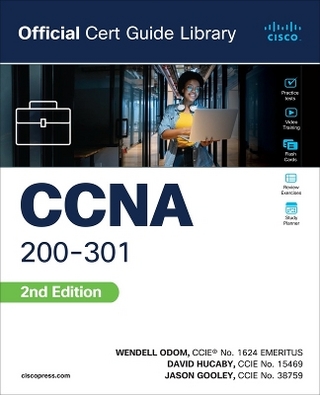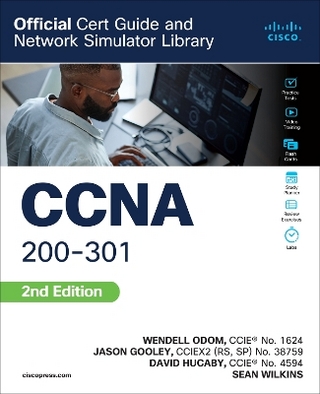
Alcatel-Lucent Scalable IP Networks Self-Study Guide
John Wiley & Sons Inc
978-0-470-42906-8 (ISBN)
By offering the new Service Routing Certification Program, Alcatel-Lucent is extending their reach and knowledge to networking professionals with a comprehensive demonstration of how to build smart, scalable networks. Serving as a �course in a book� from Alcatel-Lucent�the world leader in designing and developing scalable systems�this resource pinpoints the pitfalls to avoid when building scalable networks, examines the most successful techniques available for engineers who are building and operating IP networks, and provides overviews of the Internet, IP routing and the IP layer, and the practice of opening the shortest path first.
Kent Hundley (Alcatel-Lucent NRS I No. 1558) is a professional services IT consultant with more than 17 years of experience in the networking field. Kent has been a consultant for more than 12 years and has worked with numerous Fortune 100 enterprise clients and service provider customers in the areas of network architecture design, network operations, network management solutions, application analysis, and the design of security solutions. He is the author of several books on security and IPrelated technologies and currently works as a consultant for a leading provider of solutions for managing networks and applications.
Foreword xix
Introduction xxi
Chapter 1: Introduction To Networking 1
Pre-Assessment 2
1 1: Before the Internet 4
ARPANET: Genesis of the Internet 4
ARPANET Challenges and the Origin of TCP/IP 6
From War Room to Boardroom: The Internet Comes of Age 8
1 2: Service Providers and Content Providers 9
1 3: Modern Internet Service Providers 13
1 4: Overview of TCP/IP 15
Understanding the TCP/IP Layers 18
Forwarding Data 21
The OSI Reference Model 27
Chapter Review 31
Post-Assessment 32
Chapter 2: The Alcatel-Lucent 7750 SR and 7450 ESS Components and the Command-Line Interface 37
Pre-Assessment 38
2 1 The Alcatel-Lucent 7750 Service Router Family 40
The Alcatel-Lucent 7450 Ethernet Service Switch Group 42
Control Plane versus Data Plane 44
Physical Components of the Alcatel-Lucent 7750 SR and 7450 ESS Series 45
How Packets Are Processed by the IOM 47
Basic Bootup Components 48
System Initialization Process 50
The Boot Options 51
2 2 Command-Line Interface 54
Provisioning the Alcatel-Lucent SR/ESS Systems 58
Using Logs and Alarms 62
Practice Lab: Alcatel-Lucent 7750/7450 Hardware and the CLI 66
Lab Section 2 1: First Contact 66
Lab Section 2 2: What Is the Router Doing? Getting Help and Information 69
Lab Section 2 3: Saving Configuration Changes 75
Chapter Review 78
Post-Assessment 79
Chapter 3: Data Link Overview 83
Pre-Assessment 84
3 1 OSI Layer 2 Overview 86
Types of Data Link Layer Protocols 87
Scope of the Data Link Layer 88
3 2 Layer 2 Protocols: PPP, ATM, and Time Division Multiplexing 90
PPP: The Point-to-Point Protocol 90
Circuit-Switching and ATM 93
Time Division Multiplexing 97
Broadcast and Shared Access Data Links 98
3 3 Ethernet Overview 100
Ethernet Addressing and Operations 106
Ethernet Transmission—CSMA/CD 109
Ethernet Physical Standards 114
Practice Lab: Configuring IOMs, MDAs, and Ports 116
Lab Section 3 1: A Full Deck of Cards 117
Lab Section 3 2: An MDA for Every Need 120
Lab Section 3 3: All Ports Up to L2 Ethernet 123
Chapter Review 126
Post-Assessment 127
Chapter 4: Switched Networks, Spanning Tree, and VLANs 131
Pre-Assessment 132
4 1 Ethernet Devices: Hubs and Switches 134
4 2 Ethernet Switching Operations 136
4 3 Ethernet Link Redundancy: LAG 139
LAG Configuration 140
4 4 Ethernet Path Redundancy: STP 143
Using STP to Prevent Loops 146
4 5 Virtual LANs 154
Chapter Review 163
Post-Assessment 165
Chapter 5: IP Addressing 169
Pre-Assessment 170
5 1 Interconnecting Networks 172
The Need for Layer 3 172
How Layer 3 Functions 173
5 2 The IP Header 177
IP Header Fields 178
5 3 IP Addressing 180
Class-Based IP Addressing 184
Private IP Addressing 189
Types of IP Addresses 189
5 4 IP Subnetting 192
Identifying an IP Subnet 193
IP Subnet Address Planning 197
IP Subnets and VLSM Examples 202
Subnet Creation Exercises 207
Answers to Subnet Questions 209
5 5 CIDR and Route Aggregation—The End of Classful IP Addressing 211
CIDR versus VLSM 215
Practice Lab: IP Addressing and Routing 218
Lab Section 5 1: IP Addressing with Enterprise Customers 219
Lab Section 5 2: IP Addressing with P, PE, and CE Routers 221
Lab Section 5 3: Layer 3 Interfaces 224
Chapter Review 231
Post-Assessment 232
Chapter 6: IP Forwarding and Services 237
Pre-Assessment 238
6 1 The IP Forwarding Process 240
6 2 Typical IP Configurations 243
NAT and PAT 246
Dhcp 249
6 3 Additional IP-Related Services 252
Icmp 252
Arp 254
6 4 IP Filtering 260
Practice Lab: ICMP and ARP 267
Lab Section 6 1: Testing for ICMP and ARP 268
Chapter Review 273
Post-Assessment 274
Chapter 7: Transport Layer Services—TCP and UDP 279
Pre-Assessment 280
7 1 Understanding the Transport Layer 282
7 2 Transport Control Protocol (TCP) 284
The TCP Header 286
Establishing a TCP Connection—The Three-Way Handshake 289
TCP Reliable Data Transfer 290
TCP Flow Control 293
TCP Operation 295
Congestion Control in TCP 297
7 3 User Datagram Protocol (UDP) 300
Capabilities of UDP 301
The UDP Header 302
UDP Similarities with TCP 303
7 4 Port Numbers and Sockets 304
Chapter Review 306
Post-Assessment 308
Chapter 8: Introduction to IP Routing 313
Pre-Assessment 314
8 1 IP Routing Concepts and Purposes 316
IGPs and EGPs 317
IP Forwarding Using the Routing Table 318
Building a Routing Table 322
IP Forwarding Details 325
Selecting Routes from Multiple Routing Protocols 328
8 2 Static and Default Routes 331
8 3 Dynamic Routing Protocols 334
Practice Lab: Introduction to IP Routing 340
Lab Section 8 1: Static Routes 341
Lab Section 8 2: Default Routes and Router Logic 345
Chapter Review 350
Post-Assessment 351
Chapter 9: Ospf 355
Pre-Assessment 356
9 1 Introduction to OSPF 358
The Shortest Path First Algorithm 359
Additional OSPF Features 360
9 2 Router IDs and Their Function 361
OSPF Point-to-Point Adjacencies 362
Forming an OSPF Adjacency 364
OSPF Commands 367
9 3 Link State Updates and Flooding 375
OSPF Metrics and SPF Calculation 379
Practice Lab: Open Shortest Path First (OSPF) 381
Lab Section 9 1: Single Area OSPF 382
Chapter Review 387
Post-Assessment 388
Chapter 10: Bgp 393
Pre-Assessment 394
10 1 Interior and Exterior Gateway Protocols 396
10 2 Autonomous Systems 398
10 3 History and Features of BGP 400
10 4 BGP Metrics 403
10 5 When to Use BGP 405
10 6 Packet Details and Operation 406
BGP Update Processing 407
10 7 BGP Case Studies 408
Use Case I 408
Use Case II 410
Use Case III 411
Practice Lab: BGP Routing 412
Lab Section 10 1: External BGP Routing 413
Lab Section 10 2: Internal BGP Routing 417
Chapter Review 421
Post-Assessment 423
Chapter 11: MPLS and VPN Services 427
Pre-Assessment 428
11 1 Services Overview 430
The Building Blocks of MPLS and VPN Services 431
Understanding VPN Services 433
Understanding MPLS 435
Understanding LDP 437
11 2 MPLS in Detail 440
11 3 VPN Services in Detail 443
Vpws 444
Vpls 445
Vprn 447
Practice Lab: Services 449
Lab Section 11 1: Services Framework 450
Lab Section 11 2: VPLS Example 457
Chapter Review 464
Post-Assessment 465
Appendix A: Chapter Assessment Questions and Answers 469
Assessment Questions 470
Chapter 1 470
Chapter 2 473
Chapter 3 476
Chapter 4 479
Chapter 5 483
Chapter 6 487
Chapter 7 490
Chapter 8 493
Chapter 9 497
Chapter 10 500
Chapter 11 503
Answers to Assessment Questions 506
Chapter 1 506
Chapter 2 507
Chapter 3 509
Chapter 4 510
Chapter 5 512
Chapter 6 514
Chapter 7 516
Chapter 8 517
Chapter 9 519
Chapter 10 520
Chapter 11 522
Appendix B: Lab Exercises and Solutions 525
Chapter 2: Alcatel-Lucent 7750/7450 Hardware and the Command Line Interface 526
Lab Section 2 1: First Contact 526
Lab Section 2 2: What Is the Router Doing? Getting Help and Information 529
Lab Section 2 3: Saving Configuration Changes 534
Chapter 3: Configuring IOMs, MDAs, and Ports 538
Lab Section 3 1: A Full Deck of Cards 539
Lab Section 3 2: An MDA for Every Need 542
Lab Section 3 3: All Ports Up to L2 Ethernet 545
Chapter 5: IP Addressing and Routing 548
Lab Section 5 1: IP Addressing with Enterprise Customers 548
Lab Section 5 2: IP Addressing with P, PE, and CE Routers 550
Lab Section 5 3: Layer 3 Interfaces 554
Chapter 6: ICMP and ARP 560
Lab Section 6 1: Testing for ICMP and ARP 560
Chapter 8: Introduction to IP Routing 565
Lab Section 8 1: Static Routes 566
Lab Section 8 2: Default Routes and Router Logic 569
Chapter 9: Open Shortest Path First (OSPF) 574
Lab Section 9 1: Single Area OSPF 574
Chapter 10: BGP Routing 580
Lab Section 10 1: External BGP Routing 581
Lab Section 10 2: Internal BGP Routing 585
Chapter 11: Services 590
Lab Section 11 1: Services Framework 591
Lab Section 11 2: VPLS Example 599
Solutions 606
Lab Section 2 1 Exercises 606
Lab Section 2 2 Exercises 606
Lab Section 2 3 Exercises 608
Lab Section 3 1 Exercises 609
Lab Section 3 2 Exercises 610
Lab Section 3 3 Exercises 611
Lab Section 5 1 Exercises 613
Lab Section 5 2 Exercises 613
Lab Section 5 3 Exercises 615
Lab Section 6 1 Exercises 618
Lab Section 8 1 Exercises 620
Lab Section 8 2 Exercises 623
Lab Section 9 1 Exercises 625
Lab Section 10 1 Exercises 628
Lab Section 10 2 Exercises 629
Lab Section 11 1 Exercises 638
Lab Section 11 2 Exercises 639
Glossary 649
Index 675
| Verlagsort | New York |
|---|---|
| Sprache | englisch |
| Maße | 188 x 235 mm |
| Gewicht | 1043 g |
| Themenwelt | Mathematik / Informatik ► Informatik ► Netzwerke |
| Informatik ► Weitere Themen ► Zertifizierung | |
| ISBN-10 | 0-470-42906-2 / 0470429062 |
| ISBN-13 | 978-0-470-42906-8 / 9780470429068 |
| Zustand | Neuware |
| Haben Sie eine Frage zum Produkt? |
aus dem Bereich


